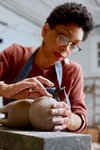Outdoor sculpture by local artists have long been part of Woodmere Museum’s landscape. But the museum’s newest addition to its sculpture garden is not constructed of metal, steel or granite. It is made of earth, fallen trees and nature’s debris.
This item is available in full to subscribers.
We have recently launched a new and improved website. To continue reading, you will need to either log into your subscriber account, or purchase a new subscription.
If you are a digital subscriber with an active subscription, then you already have an account here. Just reset your password if you've not yet logged in to your account on this new site.
If you are a current print subscriber, you can set up a free website account by clicking here.
Otherwise, click here to view your options for subscribing.
Please log in to continue |


Outdoor sculpture by local artists have long been part of Woodmere Museum’s landscape: Harry Bertoia’s undulating sculpture fountain, Dina Wind’s 30-foot metal sculpture, Robinson Fredenthal’s stainless steel “White Water.” But the museum’s newest addition to its sculpture garden is not constructed of metal, steel or granite. It is made of earth, fallen trees and nature’s debris.
“The land our museum is on was inhabited by the Lenape (Native Americans). We want to talk about the earth and what it represents,” said Bill Valerio, director and CEO of the museum. To achieve that goal, Valerio commissioned Mt. Airy artists Syd Carpenter and her husband, Steve Donegan, to design an installation for the expansive acreage behind the museum which until now had been undeveloped.
The challenge? To create art out of the natural materials of landscape. Their sculpture, “La Cresta,” is made from serpentine mounds of earth called “hugels,” a German word meaning “slope,” surrounded by slices of logs from dead trees. “The end result is a confluence of sculpture, sustainability and garden as art,” said Carpenter. At their tallest points, the hugels are about six feet high, bisected by a walking path about 50 feet long.
The hugels also serve an environmental purpose. The museum had 40 dead trees. By removing these trees and incorporating them into the design, the museum is now better able to control stormwater runoff.
“The origins of the shape come from my background as a potter. I had been in China and saw wood-fueled kilns shaped in long tunnels on ancient hills. I wanted the hugels to mimic that form,” Carpenter said.
After Carpenter and Donegan created the hugels, a team of artists and gardeners volunteered to plant native perennials designed by Carpenter. This includes geraniums, sedums and sorrel. When in full bloom, it will be an organic tapestry.
Working in the earth comes naturally to Carpenter and Donegan, who volunteer at the Ned Wolf Park in Mt. Airy and view their home garden as an art form. “When I first bought my house in 1991, I looked into the history of African American farming and gardening,” said Carpenter.
She was motivated by discovering her grandmother, Mary Schofield’s, fame as a Victory Gardener during World War II. “I learned about it from my aunt, who recently came to live with us in Mt. Airy. My grandmother’s Victory Garden fed seven children, and she shared its beauty and bounty with neighbors, making her a local celebrity in Pittsburgh. I didn’t know I had that history.”
The divide between gardening and art blurs for Carpenter. “While making sculptures, I am always thinking about what is happening in my garden,” she said.
Born in Pittsburgh, Carpenter and her family moved to Mt Airy when she was 13. She attended Girls High and received scholarship offers from the University of Pennsylvania and Temple University's Tyler School of Art. “I credit my parents with supporting my decision to go to Tyler. Everything that has been good in my life is a result of that decision.”
Now a professor of art at Swarthmore College for 30 years, Carpenter was initially known as a painter, then a maker of popular and functional ceramics and finally a ceramic sculptor. She earned her BFA and MFA at Tyler and has received awards from the National Endowment for the Arts, Pennsylvania Council on the Arts and Pew Fellowship in the Arts. Her work is in the collections of the Philadelphia Museum of Art, Metropolitan Museum of Art in New York, the Smithsonian Institute, et al.
Donegan, born in New York, studied at the School of Visual Arts in New York before moving to Philadelphia in 1976 to study painting at Tyler, where he met Carpenter.
“When I graduated Tyler, I went to see the looms at Philadelphia College of Textiles (now Jefferson University) and developed an interest in weaving,” said Donegan. “My process entails using multiple layers of images from photography, drawing and painting that are redrawn and converted into a digital file that interfaces with a computerized Jacquard loom.”
Donegan has exhibited his work from New York to New Mexico, including the American Fine Craft Show at the Brooklyn Museum and Helen Drutt Gallery in Philadelphia. His work also takes inspiration from their garden.
“Mt. Airy is a lovely place to develop as an artist,” said Carpenter. And now Woodmere is a lovelier place to visit, thanks to Carpenter's and Donegan’s efforts.
For more information, visit woodmereartmuseum.org